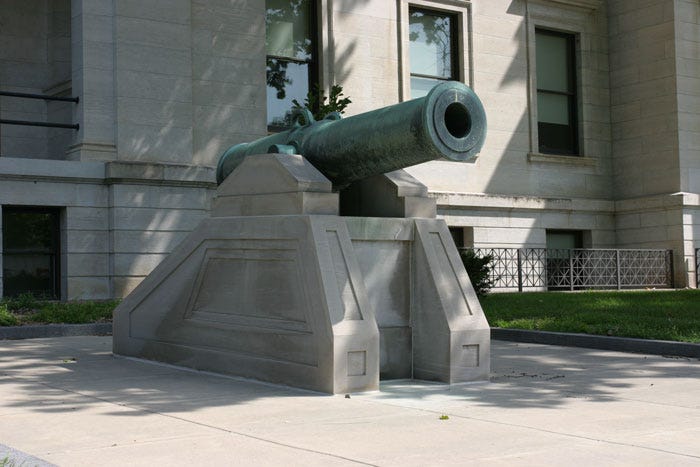Capitol Monuments

The State of Iowa Capitol Complex has a diverse group of more than 50 monuments, memorials and works of art. For a full list of monuments, including a map, download the Iowa Culture mobile app or use the online version and select Featured. Here are some highlights of what you’ll find among the monuments on the Capitol Complex:
Soldiers and Sailors Monument

The State of Iowa erected this monument to commemorate Iowans who fought during the Civil War. The monument was approved in 1888, the cornerstone was laid in 1894, and the structure was completed two years later. Because a controversy developed over the location and artistic details of the monument, nearly 50 years passed before its dedication in 1945.
Iowa artist Harriet A. Ketcham’s design for the memorial was chosen over 47 others, although she died before the monument was completed. Both real and symbolic figures are portrayed. “Victory” is the most prominent figure, topping the 135-foot structure. Four equestrians, all Iowa Civil War generals, are depicted: Marcellus M. Crocker, who joined Grant at the siege of Vicksburg; Grenville M. Dodge, who built railroads to support Grant’s army and accompanied Sherman on the March to the Sea; Samuel R. Curtis, commander of the Union Army at Pea Ridge; and John M. Corse, who was promoted to brigadier general in 1863 and assigned to the command of the Fourth Division of the Fifteenth Army Corps. The four soldiers depicted on the upper base represent Iowans who served in different branches of the military during the Civil War: Infantryman Shelby Norman, who, at the age of 18, was the first Iowan killed in battle; Ensign William H.C. Michael, a school teacher turned sailor; Artilleryman Captain Henry H. Griffiths, whose battery never lost a gun throughout the war; and Cavalryman Lt. James Horton, killed while leading a saber charge at the battle of Lovejoy Station.
Nearly 80,000 Civil War military men were from Iowa, the largest number of soldiers per capita of any state participating during the war. Noted Iowa generals and battle scenes are pictured along the base. On the north side, a statue portrays Iowa as a mother offering nourishment to her children. To the south, “History” gazes into the future, and “Iowa” is shown as a youngster.
Lincoln and Tad

A statewide penny drive among school children raised money to finance this monument. Dedicated on November 19, 1961, the anniversary of the Gettysburg Address, this sculpture was initiated two years earlier to honor the 150th anniversary of Lincoln’s birthday. Fred Torrey, a renowned Lincoln sculptor, designed and created the statue. Mable Torrey, his wife and a specialist in child sculpture, created Tad (Thomas).
Scott’s Grave

Willson Alexander Scott (1818–1859) once told friends: “When I die, I want to be buried here, where I stand…” Years later, Scott’s wish was fulfilled, on a bluff overlooking Des Moines. Scott’s gravesite is the only burial plot on the state capitol grounds.
In 1855, Scott and other speculators offered ten acres of land and promised to build a temporary capitol if the state chose their side of the Des Moines River for the new State Capitol site. After a fierce struggle between east-side and west-side interests, the state accepted the Scott group’s donation.
Scott died four years later en route to Colorado, seeking gold. His friends brought his body back to Des Moines and buried him according to his request. In 1923, the present marker was installed.
Bicentennial Fountain

In 1884, a committee appointed by Governor Buren R. Sherman chose architect John Weidenmann of New York City to design plans for improving the state capitol grounds. The plans were set aside while work on the capitol continued. Six years later, the actual project began and it was completed in 1892.
A second fountain now stands on the site formerly occupied by the Weidenmann Project’s Centennial Fountain. The original, Renaissance-style fountain was a copy of one displayed at Philadelphia’s Centennial Exposition in 1876. The ornate cast-iron work was topped with a woman holding a vase. Between its two basins, three additional female figures circled the center support. Swans and cherubs ringed the base.
After decades of vandalism and disrepair, the new fountain was ordered in 1980. The ten-foot-high Bicentennial Fountain was installed in 1982.
Spanish Howitzer

This relic of the Spanish-American War was given to the state in 1900 by the United States Department of the Navy. The bronze trophy gun came from the “Maria Theresa,” a Cuban ship sunk by the USS Iowa II in the battle of Santiago. The cannon was taken from Estrella Battery, the shore defenses at Santiago de Cuba. The muzzle loader has a smooth eight-inch bore.
Originally published at https://iowaculture.gov on August 17, 2015.
